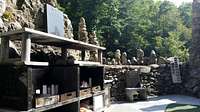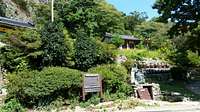|
|
Route |
|---|---|
|
|
35.75869°N / 127.41188°E |
|
|
Hiking |
|
|
Spring, Summer, Fall, Winter |
|
|
Half a day |
|
|
Easy |
|
|
I |
|
|
Overview
Just like any self-respecting road to hell, the path to Tapsa Temple is often a story of good intentions. 5 years of living in Korea had wetted my lust to climb the mystical Maisan (Horse Mountain) Peaks, 30 days of vacation gave me the opportunity. Standing in the parking lot, I had every intention of climbing to Sutmaibong Peak but the prospect of seeing 120 stone pagodas in a remote mountain temple proved to be just too tempting to pass up. Tapsa Temple is one of those places; you round a corner and you are amazed. On pretty days, the trails are full of adventure tourists, day-trip families and drunken grandmother groups. It’s still worth the effort. The odds of seriously getting your Indiana-Jones-on significantly increase if you go on a shitty, rainy, snowy day that keeps all sane people indoors. What is merely amazing on a sunny-tourist-filled day transforms into an odd combo of exotic, bizarre, and unworldly on bad weather days. If it comes down to a choice between peak or temple, take the temple this time …
Route Description
Tapsa Temple is located inside Maisan Provincial Park (Long/Lat 35.758687, 127.41188). Hiking there from the North Parking lot is the more scenic route and will take you past a 700 year-old temple (Eunsusa) on the hike. The hike is well marked without many deviations. At the top of the saddle, the trail spurs off to climb Sutmaibong (the west-ear of Maisan) otherwise it is the only route in the area and you can’t get lost. Tapsa Temple is built up a cliff in just south Sutmaibong (Elephant) Mountain. The hike is about 3.7 miles round trip (as measured by pedometer, not GPS)The hike goes as follows:
- Arrive at the north entrance via Jinan City
- From the parking lot, go up the stairs…there’s at least 600 of them…to the saddle
- The Saddle has a small sitting area to take a break right between the horse ears
- Follow the stairs down…over 600 more stair steps…to Eunsusa Temple
- Photo op in the Temple
- Head down the hill on the well-marked path; you’ll have to pay a ₩2,000 fee at a Kiosk
- Follow the trail down; Tapsa will be on your right after a short distance. Be amazed.
- Return the way you came
WHEN TO GO:
Fall is, hands down, the best time of year to go “road trip Korea”. The country is mostly deciduous forest and, as a result, transforms into a cavalcade of reds, oranges, and yellows every mid-Oct. The humidity subsides, the harvest comes in, the days are warm and the nights are cool. The downside is, of course, this “perfect” time also draws enormous crowds into the more popular venues (do not even try Mt. Sorak during the fall! It’s packed.). Spring and summer are pretty but humid; winter can get nasty but you’re much more likely to have the park to yourself.
A Little History
Eunsusa Temple (Silver Water Temple) is at least a 700-years old and an interesting destination in and of itself. Built at the very beginning of the Chosen Dynasty (around 1300), the temple has several structures and places to pray in a small compound. In addition to the temple structures (pretty traditional but worth a look), there is a large drum that visitors can strike to bring about good fortune as well as a 650-year old pear tree “Cheongsilbae” that only grows in the Maisan region. With the Sutmaibong in the background, Eunsusa is at least worth a photo op.
While Eunsusa Temple is ancient, the Taspsa Pagoda Temple complex is fairly modern. All the stone pagodas were built by a single monk, Yi Gap Yong, starting in 1885. Yi Gap Yong built over 120 pagodas by hand, without mortar and, since construction, they have withstood the ravages of wind, freeze and time without falling over. Just looking at the sheer amount of stones used in construction is mind boggling. Smaller stones were gathered locally, the bigger ones came from all points in Korea. Arriving in the area at age 25 and working on the pagodas for the next 30 years, Yi Gap Yong saw this labor as a meditation method to clear his mind and cultivate his spirit. Whether it worked or not is up to debate but Yi Gap Yong did live to 100-years old (died 1957) and left one spectacular legacy.
Red Tape and Getting There
RED TAPE
Fees for Maisan Park are nominal:
₩2,000 to park your car
₩1,000 to enter the park
₩2,000 to continue down the trail to Tapsa from Eunsusa
Restrooms are located at the Main Trailhead and the Tapsa ticket booth. Water can be refilled at Eunsusa Temple. There are snacks and soft drinks at the Tapsa ticket booth.
GETTING THERE:
The nearest metropolitan area near Maisan is Jeonju and you should be able to get direct service there from anywhere in Korea via bus or train. From Jeonju, you need to take a bus to Jinan. Once you are in Jinan, ride the local bus to Maisan Provincial Park. These buses leave every 40 minutes and start at 07:30 in morning and run until 18:00.
The Jeonju, to Jinan buses cost ₩4600, takes about 50 minutes and leaves every 20 minutes. The Jinan to the north entrance of Maisan costs ₩1200, five minutes and leaves hourly.
Renting a car to see the countryside is reasonably stress free; Korea is actually a lot better to drive in than its horrible reputation suggests, especially outside of Seoul. Getting an English language navigation system makes the drive a lot easier as signage sometimes isn’t in English and the English names for places have recently changed their spelling. Traffic laws are typically enforced by cameras---they will usually warn you prior to entering a photo-ticket area. Koreans are far less passionate drivers than they used to be and some new cars have speed-limiters and driving monitoring computers that rat them out to their insurance companies. The roads outside of Seoul are much more civilized than they used to be, so driving places is a viable option if navigation support is available.







